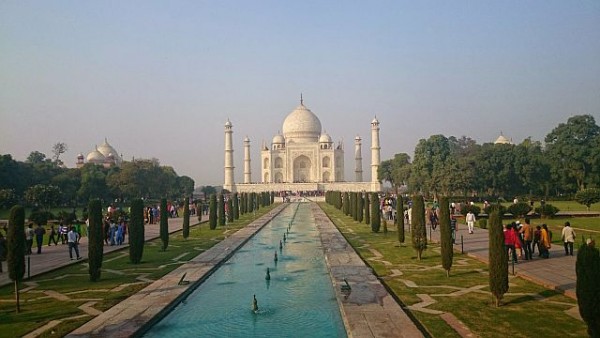Gardens of Taj Mahal Perfectly Parallel to Solstice Sun: Scientist
| Raymond Legaspi | | Feb 07, 2015 11:24 AM EST |
(Photo : Raymond Legaspi) The research of a physics professor at Italy's Polytechnic University of Turin shows that solstice alignments can be found in the Taj Mahal gardens.
The immaculate gardens of India's iconic Taj Mahal are not only a sight to behold but they align with precision to the solstice sun, an Italian physicist has discovered.
In a recently published entry in the journal Philica, physics professor Amelia Carolina Sparavigna of the Polytechnic University of Turin in Italy, said the sun alignments of the mausoleum's huge gardens are perfect.
Like Us on Facebook
She wrote in the journal that it is well known that the gardens were built with the biblical Gardens of Eden in mind - with four primary canals flowing from a spring in the center to the four corners of the globe.
It is also likely that the architects of the Taj Mahal followed the rays of the solstice sun to help build it in a location running along a north-south axis, the physics professor added.
The day is longest during the summer solstice and it is a time when the sun appears at its highest in the sky. The winter solstice, usually on December 21, is the shortest day of the year and a time when the sun appears at its lowest.
Sparavigna measured the sun alignment through the Taj Mahal using an app called Sun Calc, which taps into Google Earth to help determine the light's direction at sun-up and sundown on a particular day and place.
This means that if you make it to the Taj Mahal before sun up on the day of the summer solstice -- usually June 21 -- and stood at the north-central portion of the garden, you would see the sun rise directly over a pavilion to the northeast.
If you stay standing in that north-central spot, along the waterway, for the whole day, the sun would apparently move behind you and then set in line with another pavilion to the northwest.
The Taj Mahal's minarets and crypt, which lie between the two pavilions, would appear to be framed by the rising and setting sun.
Sixteenth century Mughal emperor Shah Jahan ordered the historic structure built for his favorite wife Mumtaz Mahal.
TagsTaj Mahal
©2015 Chinatopix All rights reserved. Do not reproduce without permission
EDITOR'S PICKS
-

Did the Trump administration just announce plans for a trade war with ‘hostile’ China and Russia?
-

US Senate passes Taiwan travel bill slammed by China
-

As Yan Sihong’s family grieves, here are other Chinese students who went missing abroad. Some have never been found
-

Beijing blasts Western critics who ‘smear China’ with the term sharp power
-

China Envoy Seeks to Defuse Tensions With U.S. as a Trade War Brews
-

Singapore's Deputy PM Provides Bitcoin Vote of Confidence Amid China's Blanket Bans
-

China warns investors over risks in overseas virtual currency trading
-

Chinese government most trustworthy: survey
-

Kashima Antlers On Course For Back-To-Back Titles
MOST POPULAR
LATEST NEWS
Zhou Yongkang: China's Former Security Chief Sentenced to Life in Prison

China's former Chief of the Ministry of Public Security, Zhou Yongkang, has been given a life sentence after he was found guilty of abusing his office, bribery and deliberately ... Full Article
TRENDING STORY

China Pork Prices Expected to Stabilize As The Supplies Recover

Elephone P9000 Smartphone is now on Sale on Amazon India

There's a Big Chance Cliffhangers Won't Still Be Resolved When Grey's Anatomy Season 13 Returns

Supreme Court Ruled on Samsung vs Apple Dispute for Patent Infringement

Microsoft Surface Pro 5 Rumors and Release Date: What is the Latest?













